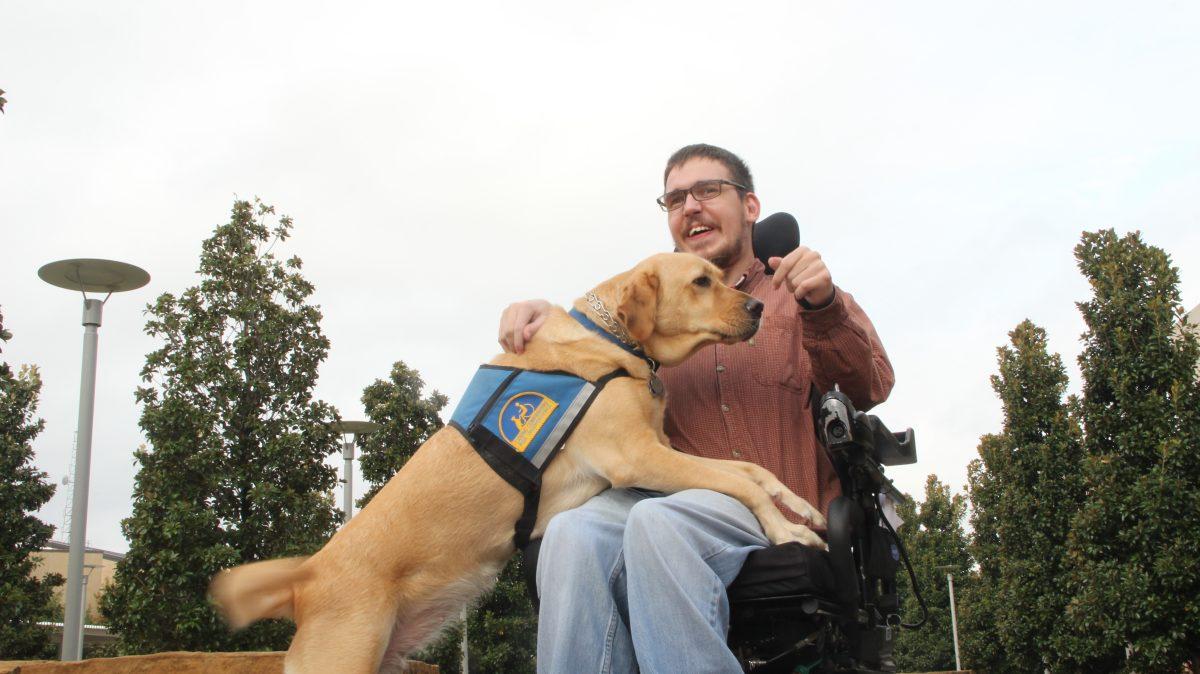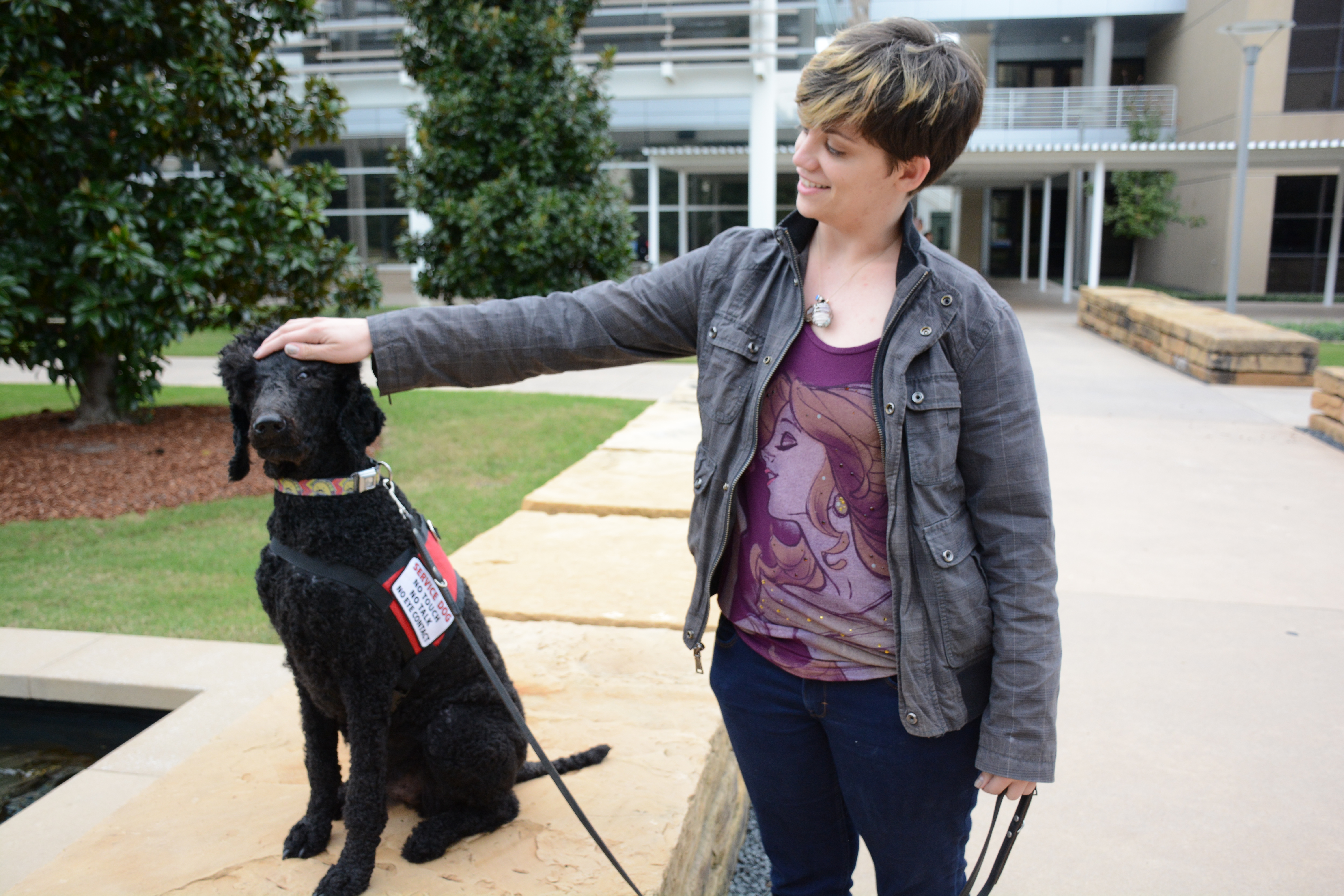Service dogs help owners on campus live easier lives
Matthew Schroeder has had a much easier time dealing with certain aspects of being confined to a wheelchair ever since Lauren came into his life.
The two have become practically inseparable. Lauren’s a loyal friend and a constant, comforting presence.
She’s also a golden retriever.
More than pets
Schroeder, a graduate student studying literature, has to use a wheelchair due to his severe cerebral palsy. He filled out an application a year and a half ago for a service dog through an organization called Canine Companions for Independence. This past April, he got Lauren, who is now two years old.
Lauren is trained to pick items off of the ground, push buttons to open doors and bark on command if Schroeder were to fall out of his chair.
Although she was fully trained when she arrived, Schroeder said he still works on strengthening her commands.
Through their work together, Schroeder and Lauren have become boon companions.
“It’s really nice to be able to come home and know someone’s excited to see you and you just feel more comfortable because you’re not alone,” he said.
Jennifer Burrhus, a senior in arts and performance, also keeps a service dog on campus. She trained Gatsby, her 3-year-old poodle, herself after determining that the price of and wait for a service dog wasn’t right for her.
“I don’t know exactly why I started looking into it a little bit more, but once I did I realized there were things a dog could actually help me with and it was actually a feasible option for me,” Burrhus said.
Burrhus suffers from fibromyalgia, which affects her balance and causes her chronic pain. She also has mercury poisoning from her dental fillings, resulting in high anxiety levels and panic attacks.
There is no certification under U.S. federal law for a dog to be qualified as a service animal — it just has to be trained to do at least one thing to help its owner.
Gatsby is trained to be alert to changes in Burrhus’ body that signal the onset of a panic attack before she herself is even aware one is coming. He can also help her up if she falls.
Burrhus said poodles are an empathetic breed of dog. The breeder she got Gatsby from tested the temperament of the whole litter to find the best puppy for what she needed. Still, she said there were challenges to training a service dog all by herself, especially when she had to teach him to respond to her physiological changes.
“I had to be very aware of how I was feeling,” Burrhus said. “So I had to really intensely focus on what I was feeling at any given point so that I could actually reward him for responding to it.”
She is still teaching him new commands and tricks. He recently learned how to circle around her, giving her a buffer in crowds.
“There’s always new things they can learn,” she said. “If you stop training, they’re just going to regress.”
Although Burrhus and Gatsby are able to work together successfully now, she said there was a learning curve to working with a service animal.
“I got accosted in the post office until I was crying in a corner in a ball because no one would believe me that he’s actually a service dog,” she said. “Those (situations) don’t happen as much anymore and I think it’s just because, at first, I didn’t have as much confidence in me and Gatsby as a team.”
A Team Effort
Although exceptionally well trained, Schroeder said Lauren is just as high-spirited and playful as any other dog. However, he said she is very aware of her role at all times.
“When she’s not on the clock, she enjoys fetch and tug of war and all the same things that regular dogs do,” Schroeder said. “She gets plenty of time to be a normal dog and plenty of time to be a service dog.”
Although he’s only had her for about half a year, Schroeder said Lauren and he are a package deal.
“At this point, Lauren, for me, is nonnegotiable,” he said. “Wherever I’m going to be, I’m more than likely going to have Lauren with me.”
Similarly, Burrhus and Gatsby are almost always in sync with each other.
“He’s the best dog I’ve ever had. He takes really good care of me,” she said. “We trust each other.”
Even though Schroeder and Lauren are inseparable now, he said there are things he is noticing about how he interacts with people since having a service dog that he was able to write off before.
“People treat me very differently depending on whether or not I have Lauren,” he said. “When I have Lauren, people smile at me and they look at me and I’m much more of a presence. When I don’t have Lauren, people deliberately avoid direct eye contact and sort of try to ignore me as much as possible … It’s just weird to get used to being noticed and then stop being noticed sometimes just because you don’t have an animal with you”
Burrhus said she has experienced something similar. She said she’s noticed that it is obvious to her when someone seems more interested in being the dog’s friend than hers.
“It’s like being that invisible friend. Like you’re there with a group and no one remembers you being there,” she said. “Sometimes it’s disheartening, but I appreciate people that actually remember my name before they remember the dog’s name”
Distractions
Because it is so common for people to approach someone with a dog in tow, Burrhus and Schroeder both stressed the importance of getting the owner’s express permission before distracting a service dog.
“When you see them out in public, they’re working. So be very careful about touching them or anything because that can distract them a lot, which makes them less obedient and can put them in dangerous situations at times,” Schroeder said. “That being said, don’t hesitate to ask if you can pet a service dog.”
Burrhus has had experiences with someone distracting a service dog that resulted in a serious injury. She knew someone with a seizure disorder and, because he was distracted, the dog missed the alert so the owner didn’t have enough time to get to a safe place. She ended up falling and hurting herself.
She also cautions against anyone trying to get Gatsby’s attention while he’s on the job.
“If he just so happens to look, be distracted, maybe take a step towards them and I need him, he’s not there for me and I could fall,” she said.
Burrhus and Gatsby and Schroeder and Lauren are just a couple of the pairs of owners and service dogs on campus. Through their relationships with their animals, Burrhus and Schroeder have both a comforting companion and someone to make sure they stay healthy and happy.
“I feel more confident because I’m taking care of another living being and I know that I’m capable of that,” Schroeder said. “I know that I’m able to bring people joy just by being around because she’s with me, and that’s really great to me.”






